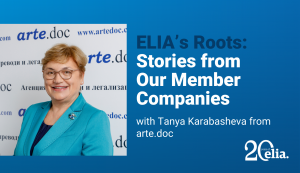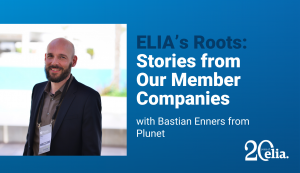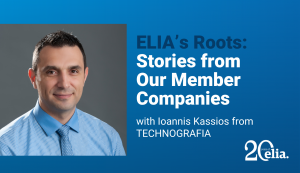In this final article of ELIA’s 2025 ELIS Discussion Series, we explore the ELIS report’s assertion: “The balance between technology and human services is broken.” To unpack that statement, we wanted to explore what’s happening to the localisation workflows and why new solutions result in less work—and perhaps also less satisfying work—for humans.
All company segments below €10 million reported an average revenue decline in 2024. A striking 77% of LSC respondents say this downturn stems from structural shifts—especially the rapid adoption of language technology and changes in client procurement behaviour.
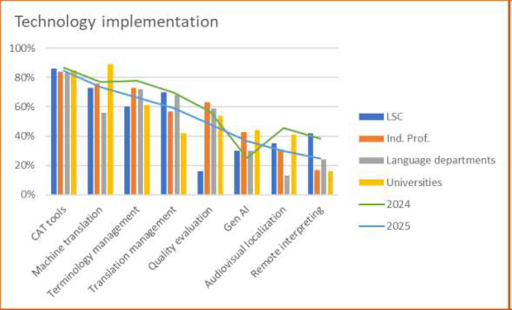
While 14% believe conditions will return to “normal,” and 9% cite external economic or geopolitical factors, most see this as a transformation rather than a temporary dip. On the buyer side, language departments expect tighter budgets and more competition but remain confident the market isn’t shrinking.
So what’s really changing—and how do we adapt?
Joining the discussion are Anu Carnegie-Brown (ACB), Ursula Steigerwald (US), and Stéphane Hue (SH), and Diego Cresceri (DC, from ELIA’s AI Committee), who dive into what this imbalance means for the industry’s future.
Anxiety and Frustration: AI’s Impact on Human Linguists
This year’s ELIS participants were disappointed with what they saw as indiscriminate use of language technology, particularly AI and machine translation, to cut costs and replace human translators. Responses showed anxiety and frustration, with many still unsure how to adapt.
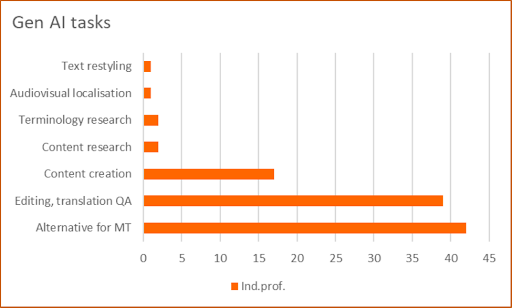
The main trend was the rise of AI and MT, seen by some as a tool for efficiency but blamed by most for degrading rates and quality and driving professionals away. Language professionals on the buyer side had a more neutral view, acknowledging that these technologies helped them meet their organisation’s requirements.
AI-Driven Workflows
ACB: What new technology solutions are buyer-side companies using that impact the volume or quality of work left for human linguists?
DC: The biggest shift on the buyer side has been the adoption of generative AI and LLM-enhanced workflows. Many companies are now integrating LLMs (e.g., OpenAI’s GPT, Google’s Gemini, or Meta’s LLaMA) into internal content creation and translation pipelines. These technologies are used for:
- Content optimisation: LLMs rewrite or optimise source content for better MT output, reducing ambiguity and improving translatability.
- Pre-translation: Content is run through MT engines or LLMs fine-tuned to the buyer’s domain and tone.
- Automated quality checks: LQA and terminology validation are increasingly done by AI before content reaches a human linguist.
As a result, the work volume left for human linguists is decreasing, particularly for content types like product descriptions and support articles, but the use cases for LLMs are growing in number.
ACB: And what technology solutions are LSCs adopting?
DC: There are AI-powered production pipelines some LSCs are investing in:
- MT engine orchestration platforms (e.g., Intento, CustomMT, even Blackbird) dynamically select the best engine per language pair or domain, improving raw MT quality and reducing human intervention.
- LLM-based post-editing assist tools don’t replace human post-editors but help by flagging segments needing attention, suggesting rewrites, or comparing MT to translation memories.
- Custom-trained LLMs or AI agents automate LQA or translation output scoring, enabling LSCs to scale their QA processes and lower the cost per word.
To sum up the impact, here’s what a localisation workflow might now look like compared to five years ago. Not everyone is doing it like this yet, but this is presented as a good scenario to aim for.
| In 2020 | Now |
| Manually created source content | Source content optimised by AI |
| Human translation or MT + human post-editing of all segments | MT + LLM-assisted quality prediction: Every segment is machine translated and passed through an AI model that predicts its “confidence” score or quality Segment triaging where human linguists work 100% as post-editors and quality reviewers: High-confidence segments are auto-approved or lightly reviewed. Medium/low-confidence segments are routed to human linguists to edit. |
| Human revision or review of all segments | |
| Manual QA and LQA (tools were used but the process was people-driven) | |
| Feedback loops that were slow and mostly Excel-based | Real-time LQA dashboards that are powered by AI |
US: I think we should add here that this is what everybody might be aiming at—but Excel is still very present from what we are seeing in our daily work.
Industry Pressures and a Push for Rebranding
According to ELIS2025, language companies primarily reported a direct negative impact of AI on their business, primarily due to decreased rates for post-editing services or reduced client outsourcing. Language departments on the client side shared similar concerns, with nearly half expressing apprehension that AI might undermine their department’s position. This concern is valid because internal clients may adopt AI independently, bypassing language departments.
At the end of May 2025, Slator declared the terms Language Service Provider and Translation Management System outdated, rebranding LSPs as Language Solutions Integrators (LSIs) and TMSs as Language Technology Platforms (LTPs). LSIs deliver multilingual content solutions by integrating language technology, AI, and experts into managed services, whilst LTPs focus on language tools, orchestration platforms, and AI models.
The ‘Factory’ Analogy and New Roles
ACB: With clients taking more active roles in multilingual content creation and localisation, what should our role as LSIs entail?
SH: I think we can use the factory metaphor to understand what’s happening. We’re shifting from operating translation factories ourselves to becoming engineers who design and maintain them for our clients. Instead of processing source content and delivering translations, we’re helping organisations build their in-house translation capabilities using LLMs, automation, and human oversight.
US: Clients need our expertise in selecting, implementing, and running this technology. They also need linguistic input for quality checking, training AI, and post-editing machine output.
ACB: To provide such value, we need skilled language engineers who specialise in technology integration and linguists adept at client interaction and efficiently post-editing fragmented AI-translated texts. This requires new payment models based on expertise rather than per-word rates.
SH: This transition opens new revenue models where we sell engineering time and ongoing support through retainers, completely decoupled from translation volume.
DC: New roles include AI post-editors, AI language specialists, AI voice post-editors, and prompt engineers. There’s increasing demand for top-quality linguists for content AI can’t process, and the Accessibility Act is creating additional roles.
Looking Ahead
The ELIS 2025 survey confirms that our industry is at a turning point. Technology is advancing quickly, and the balance between automation and human value is being redefined. While these changes bring uncertainty, they also create space for new expertise, sustainable roles, and long-term partnerships built on trust, integration, and adaptability.
Restoring that balance—between scale and service, tools and talent—is our challenge and opportunity for the years ahead.
How is your company adapting to these changes? Are you embracing AI-driven workflows, redefining roles, or rethinking your value propositions?
Join the conversation on LinkedIn using #ELIAdiscussion, and share your perspectives. We’ll continue exploring this topic in our next series leading up to Networking Days 2025: Opportunity Knocks: Playing the AI Game. Let’s get together and grow together, to build a resilient, human-focused future for our industry.

